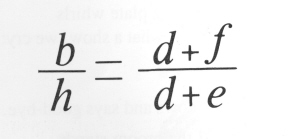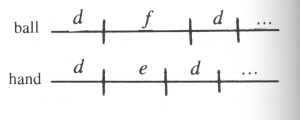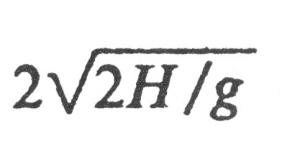|
The Physics of Juggling's Ups and Downs By
Joe Buhler and Ron Graham Jugglers
around the world make millions of upward tosses daily without ever
considering why objects fall back into their hands. For those not
capable or caring enough to figure it out, the two juggling
mathematicians who wrote this article have described the ultimately
important mechanics of this pure motion. All the everyday juggler need remember is:
(The
following information on the kinematics of juggling is excerpted
from a longer article that Buhler and Graham have written for
publication in La Recherche, a French scientific journal.) The
essence of juggling is the stabilization of a pattern by using
feedback to accommodate and correct minor variations. Some possible
sources of variation are obvious - throws that have slightly
incorrect destinations or slightly incorrect heights. Another
important variable is the timing of the throws.
Jugglers
instinctively learn that there are constraints placed on their
patterns by the necessity of timing the throws correctly. If a ball
is thrown too late another ball drops (the performer's nightmare)
and if it is thrown too early the pattern can degenerate quickly
into instabilities that can not be dampened.
In
order to quantify some of these constraints we will consider an
idealized juggling pattern.
Suppose
that a pattern has a fixed number of hands and balls and that it is
such that each ball follows the same path, each ball takes the same
time in flight, and each ball spends the same amount of time in a
hand. More precisely the following five quantities are all assumed
to be constant:
b:
the number of balls h:
the number of hands f: the flight time of each balI between hands e:
the empty time - the time a hand is empty between balls d:
the dwell time - the time each ball spends in a hand.
Furthermore
we assume, for the convenience of exposition, that two balls are
never in the same hand at the same time and that the pattern is
periodic in the sense that each configuration reoccurs at fixed time
intervals.
These
assumptions imply that the juggling pattern has a certain symmetry
and uniformity in addition to a stable pattern and rhythm. The
cascade is an example of a pattern for which these assumptions are
valid, and the shower is an example for which the assumptions are
not valid. These ideas can be generalized to yield (somewhat more
complicated) results in the absence of these assumptions; any
pattern can be analyzed.
The
basic relationship is:
This
should be regarded as a constraint that
interrelates the above variables. It would
be. nice to call this result Shannon's Theorem since it is
due to the mathematician Claude Shannon,
but several of the seminal results in coding and information
theory already bear that name.
It
is not too hard to see why something like
this must be true. Consider one period of
the "time line" of the typical hand and typical ball:
Here
d denotes an interval in which
the ball is in a hand. f denotes an interval in which
the ball is in flight, and e denotes the interval in
which the hand is empty. Thus, if a hand holds
m balls in one period of the pattern and
a ball visits n hands in a period, then the total number
of ball/hand contacts can be counted in two ways; we deduce
that: bn=hm
The total period length can be computed In two ways - either by looking at the ball timeline or the hand time-line. The result is that
The
flight time f is directly related to
the height of a throw so that this result can also be
regarded as a constraint on the height of
a throw.
Indeed, the height of a throw uniquely determines its flight time. If a ball follows a parabolic path and is thrown to height H. then the ball takes time
to return to a hand at the same level. Here g is the acceleration due to gravity (roughly 9.8 m/second squared). Jugglers are intuitively aware of the fact that if the flight time (and hence the height) is fixed then it is still possible to juggle at different speeds. This can be quantified by using Shannon's result. |



